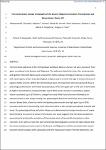Terrestrial carbon isotope stratigraphy of the Eocene–Oligocene transition, Petrockstowe and Bovey basins, Devon, UK
| dc.contributor.author | Chaanda, MS | |
| dc.contributor.author | Grimes, ST | |
| dc.contributor.author | Jerrett, RM | |
| dc.contributor.author | Anderson, M | |
| dc.contributor.author | Leng, MJ | |
| dc.contributor.author | Fitzpatrick, ME | |
| dc.contributor.author | Price, GD | |
| dc.date.accessioned | 2023-08-07T12:15:19Z | |
| dc.date.available | 2023-08-07T12:15:19Z | |
| dc.date.issued | 2023-06 | |
| dc.identifier.issn | 0016-7878 | |
| dc.identifier.uri | https://pearl.plymouth.ac.uk/handle/10026.1/21172 | |
| dc.description.abstract |
The terrestrial sediments of the Petrockstowe and Bovey basins in Devon, UK were examined. Their age is considered to be Eocene and Oligocene. The sediments (kaolinitic clays, silts, sands, gravels, and lignites) from both basins were analysed for carbon isotopes of organic material, in conjunction with total organic carbon and palynological analyses used to unravel the type of and provenance of organic matter present. Within the Petrockstowe Basin, the lowermost interval examined shows a palynological distribution dominated by phytoclasts, whilst the upper part of the core is dominated by higher concentrations of palynomorphs (up to 90 %) and an increase in amorphous organic matter consistent (up to 37 %) with a change from sand-filled fluvial channels followed by an ephemeral lake or lake margin setting. Our palynological data from the South John Acres Lane Quarry section, Bovey Basin, show that within the lignites palynomorphs are high again (up to 95 %) consistent with them representing more ephemeral lakes or lake margins periodically exposed with mires. Our palynological data set further allows us to determine that isotope trends are not overly determined by the source of carbon in the basins. Our study suggests that the observed patterns were primarily produced by variations of the isotope ratios of terrestrial atmospheric carbon reservoirs. Even with our less than well constrained biostratigraphical control, the data indicate that the carbon isotope excursions seen in the Eocene and Oligocene could be associated with several transient carbon isotopic shifts (associated with the Paleocene–Eocene Thermal Maximum). Our findings therefore appear to lend support to the surface ocean and atmosphere behaving as coupled reservoirs at this time. | |
| dc.format.extent | 517-525 | |
| dc.language | en | |
| dc.publisher | Elsevier BV | |
| dc.subject | Eocene-Oligocene Petrockstowe Bovey terres-trial carbon isotope | |
| dc.subject | Palynological analyses | |
| dc.title | Terrestrial carbon isotope stratigraphy of the Eocene–Oligocene transition, Petrockstowe and Bovey basins, Devon, UK | |
| dc.type | journal-article | |
| dc.type | Article | |
| plymouth.issue | 5-6 | |
| plymouth.volume | 134 | |
| plymouth.publication-status | Published | |
| plymouth.journal | Proceedings of the Geologists' Association | |
| dc.identifier.doi | 10.1016/j.pgeola.2023.05.003 | |
| plymouth.organisational-group | |Plymouth | |
| plymouth.organisational-group | |Plymouth|Research Groups | |
| plymouth.organisational-group | |Plymouth|Faculty of Science and Engineering | |
| plymouth.organisational-group | |Plymouth|Faculty of Science and Engineering|School of Geography, Earth and Environmental Sciences | |
| plymouth.organisational-group | |Plymouth|Research Groups|Marine Institute | |
| plymouth.organisational-group | |Plymouth|REF 2021 Researchers by UoA | |
| plymouth.organisational-group | |Plymouth|Users by role | |
| plymouth.organisational-group | |Plymouth|Users by role|Academics | |
| plymouth.organisational-group | |Plymouth|REF 2021 Researchers by UoA|UoA07 Earth Systems and Environmental Sciences | |
| plymouth.organisational-group | |Plymouth|Users by role|Researchers in ResearchFish submission | |
| dcterms.dateAccepted | 2023-05-26 | |
| dc.date.updated | 2023-08-07T12:15:06Z | |
| dc.rights.embargodate | 2023-8-8 | |
| dc.rights.embargoperiod | forever | |
| rioxxterms.versionofrecord | 10.1016/j.pgeola.2023.05.003 |


